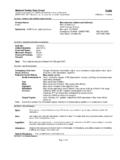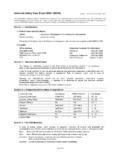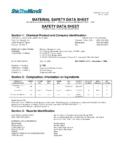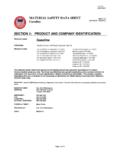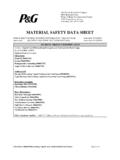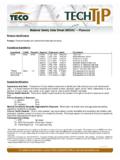Transcription of Material Safety Data Sheet Tetrahydrofuran MSDS …
1 Material Safety data Sheet Tetrahydrofuran msds Date: 02/1/2009. SECTION 1: PRODUCT AND COMPANY IDENTIFICATION. Product Name: Manufacturer's Name and Address: Tetrahydrofuran Penn A Kem 3324 Chelsea Avenue Synonyms: THF Memphis, TN 38108. Tetramethylene oxide Emergency Number, if inside US: (901) 320 4003. Stabilized THF Emergency Number, if outside US: (877) 895 7366. SECTION 2: Composition/Information on Ingredients CAS NO.: 109-99-9. EINECS/ELINCS: 203-726-8. Chemical Name: Tetrahydrofuran Molecular Weight: 72. Chemical Formula: C4H8O. Percent: Note: This Material is normally stabilized with an antioxidant, less than wt%. SECTION 3: Hazards Identification Emergency Overview: This Material is HAZARDOUS by OSHA Communication definition. Signal Word: Danger. NFPA Rating: Health: 2; Flammability: 3; Reactivity: 1. NHIS Rating: Health: 3; Flammability: 3; Reactivity: 1. Possible human carcinogen (NTP report 12/96). Hazards: Clear, colorless liquid, ether-like odor. Highly flammable.
2 Avoid oxidizing agents. May be reactive if not inhibited. Avoid prolonged or repeated breathing of gases, vapors or mists. Severe skin irritant. Skin absorption hazard. Eye irritant. Central nervous system effects. Mucous membrane irritant. Irritating to gastrointestinal tract. Potential Health Effects: Eye: Eye irritant. Skin: Skin irritant - defatting. Not expected to be a sensitizer. Ingestion: Moderate ingestion hazard. May cause irritation of the digestive tract. Inhalation: Causes narcotic effect in high concentration. May cause respiratory tract and mucous membrane irritation. May cause unconsciousness or respiratory arrest. Chronic: Repeated or prolonged exposure may result in liver damage or may cause dermatitis by defatting the skin. Target Organs: Skin, eye, central nervous system and liver. Note: May aggravate pulmonary/bronchial disease and/or cause breathing difficulties. SECTION 4: First Aid Measures Eyes: Flush eyes with plenty of water for at least 15 minutes, occasionally lifting the upper and lower eyelids.
3 Get medical aid. Skin: Flush skin with plenty of water for at least 15 minutes while removing contaminated clothing and shoes. Wash skin thoroughly with mild soap and water. Wash clothing before reuse. Get medical aid if ill effects or irritation develops. Ingestion: Do not induce vomiting. Never give anything by mouth to an unconscious person. If conscious and alert, rinse mouth and drink water. Get medical aid. Inhalation: Remove from exposure and move to fresh air immediately. If not breathing, give artificial respiration. If breathing is difficult, give oxygen. Get medical aid if breathing difficulty persists. Page 1 of 6. Material Safety data Sheet Tetrahydrofuran msds Date: 02/01/2009. SECTION 5: Fire Fighting Measures General Information: As in any fire, wear a self-contained breathing apparatus in pressure- demand, MSHA/NIOSH (approved or equivalent), and full protective gear. During a fire, irritating and highly toxic gases may be generated by thermal decomposition or combustion.
4 Vapors may be heavier than air. They can spread along the ground and collect in low or confined areas. Cool containers with flooding quantities of water. Extinguishing Media: Small fire use water spray, dry chemical, carbon dioxide. Large fire use water spray, water fog dry chemical, carbon dioxide, or alcohol resistant foam. DO NOT USE SOLID WATER STREAM. Flash Point: 6 F, -14 C. Auto ignition Temperature: 610 F, 321 C. Explosion limits, Lower: Upper: NFPA Rating: Health: 2; Flammability: 3; Reactivity: 1. NHIS Rating: Health: 3; Flammability: 3; Reactivity: 1. Possible human carcinogen (NTP report 12/96). SECTION 6: Accidental Release Measures General Information: Eliminate all sources of ignition. Use proper personal protective equipment as indicated in Section 8. Spills/Leaks: Absorb spill with inert non-combustible Material ( vermiculite, sand or earth), then place in a suitable container. Clean up spills immediately using non-sparking tools. Provide ventilation. SECTION 7: Handling and Storage Handling: Wash thoroughly after handling.
5 Remove contaminated clothing and wash before reuse. Use with adequate ventilation. Avoid contact with eyes, skin, and clothing. Keep container tightly closed. Avoid ingestion and inhalation. Handle empty containers with care. Vapor/residues may be flammable. Storage: Keep container closed when not in use. Store in a tightly closed container. Store in a cool, dry, well-ventilated area away from incompatible substances. SECTION 8: Exposure Controls, Personal Protection Engineering Controls: Facilities storing or utilizing this Material should be equipped with an eyewash facility and a Safety shower. Use adequate ventilation and exhaust to keep airborne concentrations low. Exposure Limits: Chemical name: tetrahydofuran ACGIH: 50 ppm 8hrs/TWA. 100 ppm 15 min/STEL. OSHA 200 ppm 8hrs/TWA. Page 2 of 6. Material Safety data Sheet Tetrahydrofuran msds Date: 02/1/2009. SECTION 8: Exposure Controls, Personal Protection Cont'd Personal Protective Equipment: Eyes: Wear appropriate protective eyeglasses or chemical Safety goggles and face shield as described by OSHA's eye and face protection regulations in 29 CFR or European Standard EN166.
6 Hands: Wear appropriate protective gloves to prevent skin exposure. Polyvinyl alcohol, Teflon, or 4H and Silver Shield brand. Butyl or natural rubber offer short term protection and should be removed and discarded when Material is spilled on them. Clothing: Wear appropriate protective clothing to prevent skin exposure. Respirators: A respiratory protection program that meets OSHA's 29 CFR and ANSI requirements or European Standard EN 149 must be followed whenever workplace conditions warrant respirator use. SECTION 9: Physical and Chemical Properties Physical State: Liquid Appearance: Clear, colorless. Odor: Ether-like odor. pH: ~ 7. Vapor Pressure: 155 mm Hg @ 25 C (77 F). Vapor Density: Evaporation Rate: Not available. Viscosity: @ 25 C. Boiling Point: 66 C (151 F) at 760. mm Hg Freezing/Melting Point: - 108. C (-163 F). Autoignition Temperature: 321 C. Solubility: water Completely miscible. Specific Gravity/Density: g/cc. Molecular Formula: C4H8O. Molecular Weight: 72. SECTION 10: Stability and Reactivity Chemical Stability: Stable under normal temperatures and pressures so long as it is inhibited.
7 Conditions to Avoid: Incompatible materials, excess heat, strong oxidants. If unstabilized, avoid air and oxygen. Forms unstable peroxides with oxygen. Do not distill to dryness unless the Material is tested for peroxides. Incompatibilities with other Materials: Strong oxidizing agents. Hazardous Decomposition Products: Carbon monoxide, irritating and toxic fumes and gases, carbon dioxide. Hazardous Polymerization: Polymerization can occur with very strong acids. Page 3 of 6. Material Safety data Sheet Tetrahydrofuran msds Date: 02/01/2009. SECTION 11: Toxicological Information LD50 Oral rat 3240 mg/kg LC50: Ihl rat 18,000 ppm 4 hr Carcinogenicity: Not listed by IARC, NTP, OSHA or EPA. Epidemiology: No information available. Sensitization Not expected to be a skin sensitizer. Eye Liquid and vapor is irritating to eyes. Skin Severe skin irritant. Teratogenicity: Not a teratogen. Reproductive Effects: No effects on fertility or reproduction were found in rats administered high doses of Tetrahydrofuran in drinking water.
8 General systemic toxicity was evident in parental animals at high drinking water doses that were correlated with reduced body weights and developmental delays in the offspring. Genetic toxicity: Negative for genotoxicity in vitro and in vivo Neurotoxicity: No information available. Other Studies: No information available. SECTION 12: Ecological Information Acute toxicity fish LC50/96 hrs fathead minnow, 2,160 mg/l Invertebrates EC50/24 hrs daphnia 5,930 mg/l Aquatic plants NOEC /8 day algae 3,700 mg/l Not toxic to algae or higher aquatic plants. Microoganisms No data available. Other Studies: Biodegradation under aerobic conditions. Degrades abiotically in SECTION 13: Disposal Considerations Contaminated products, oil or water may be a US RCRA or OSHA hazardous waste due to a potentially low flash point. US EPA guidelines for the classification determination are listed in 40 CFR Parts Additionally, waste generators must consult state and local hazardous waste regulations to ensure complete and accurate classification.
9 SECTION 14: Transport Information US DOT. Shipping Name: Tetrahydrofuran RQ 1000 lb Hazard Class: Flammable liquid UN Number: UN2056. Packing Group: II. Page 4 of 6. Material Safety data Sheet Tetrahydrofuran msds Date: 02/01/2009. International Shipping Name: Tetrahydrofuran Hazard Class: Flammable liquid UN Number: UN2056. Packing Group: II. SECTION 15: Regulatory Information US FEDERAL: TSCA (Toxic Substance Control Act): Tetrahydrofuran is listed on the TSCA inventory. TSCA Section 12b: Tetrahydrofuran is listed under TSCA Section 12b. Export notification is required. TSCA section 4. CERLA Hazardous Substances Tetrahydrofuran CAS 109-99-9 has an RQ of 1000 lb. and Corresponding RQs: SARA Section 302 (Superfund Amendments and Reauthorizations Act): SARA 311/312 Based on available information, Tetrahydrofuran is classified as follows: Immediate (Acute) Health Hazard Delayed (Chronic) Health Hazard Fire Hazard 313 Reportable Ingredients: None of the chemicals are reportable under Section 313.
10 Clean Air Act: This Material does not contain any Class 1 Ozone depletors, or Class 2 Ozone depletors. Clean Water Act: None of the chemicals in this product are listed as Hazardous Substances, Priority Pollutants, or Toxic Pollutants under the CWA. STATE: Tetrahydrofuran CAS # 109-99-9 is present on state lists PA (hazardous substances and environmentally hazardous substances), MA (MSL, hazardous substance). California Prop 65: California No Significant Risk Level: None of the chemicals in this product are listed. European/International Regulations European Labeling in Accordance with EC Directives: Hazard Symbols: . Risk Phrases: R11 Highly Flammable. R19 May form explosive peroxides. R36/37 Irritating to eyes and respiratory system. Safety Phrases: S 24/25, Avoid contact with skin and eyes. S 37, Wear suitable gloves. S 45, In case of accident or if you feel unwell, seek medical advice immediately (show the label where possible). S 28A, In case of skin contact, wash immediately with plenty of water.
